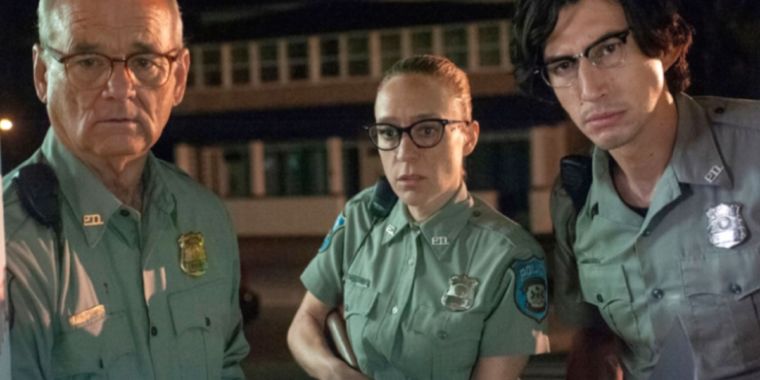

/ Bill Murray, Chloë Sevigny, and Adam Driver star in Director Jim Jarmusch’s
The Dead Don’t Die.
With The Dead Don’t Die, auteur director Jim Jarmusch puts his unique, deadpan stamp on this staple of the horror genre. As one might expect, Jarmusch’s vision is more ironically cerebral than your typical zombie fare and a bit less viscerally horrifying—even when the aforementioned dead are chowing down on their victims’ viscera. It’s not a perfect film, but it’s got Tilda Swinton brandishing a katana with deadly accuracy against the undead. What’s not to love?
(Some spoilers below.)
Zombies might seem an odd choice of subject matter for this longtime darling of the Cannes Film Festival crowd. Jarmusch’s career took off in 1984 with his first major film, Stranger Than Paradise. Shot entirely in black-and-white (a signature of the director’s early work), the film won the Caméra D’Or at Cannes that year and established the director as a rising creative force in arthouse cinema.
Movies like Dead Man, Mystery Train, Down by Law, Night on Earth, and Ghost Dog: The Way of the Samurai further cemented his auteur status. In 2005, Jarmusch won the Grand Prix at Cannes for Broken Flowers, which starred Bill Murray as a middle-aged man searching for the mother of the son he never met. And Jarmusch is no stranger to unusual takes on traditional horror stories, as evidenced by his 2013 “crypto-vampire love story,” Only Lovers Left Alive.
The trailer dropped in April, raising hopes that the genre might be tailor-made for Jarmusch’s idiosyncratic style and ultra-dry wit—especially given the rise in zombie-themed comic horror over the last 15 years, starting with 2004’s Shaun of the Dead. The director’s vision harkens back to classic George Romero zombies (Romero originally called them “ghouls”): they’re slow, shuffling, barely sentient creatures who aren’t particularly discriminating in their diet, in that they’ll eat any part of the human body, not just brains. And they’re easily offed by destroying the head—at least until their numbers grow so large that they simply outnumber and overpower any humans in their way.
The humans in this case are the residents of a small rural town called Centerville. They start to notice some strange phenomena, possibly due to fracking at the polar ice caps knocking the Earth off its axis. Somehow (Jarmusch wisely doesn’t bother coming up with a better explanation) this serves to reanimate the dead, with predictably terrible consequences for the people of Centerville. It’s up to Chief Cliff Robertson (Bill Murray) and Officer Ronald “Ronnie” Peterson (Adam Driver) to keep the town safe from the growing zombie horde—a task for which they are woefully unprepared, despite Ronnie’s handy knowledge of zombie lore.
-
Centerville looks like such a pleasant town.
-
Zombies attack a diner waitress
YouTube/Focus Features -
“I’m thinking zombies. You know, the undead. Ghouls.”
-
Hank Thompson (Danny Glover) tells Chief Cliff Robertson (Bill Murray) what he knows.
YouTube/Focus Features -
Chloë Sevigny plays a police officer.
YouTube/Focus Features -
Farmer Miller (Steve Buscemi) wonders what all the fuss is about.
YouTube/Focus Features -
A fresh empty grave is not a good sign.
YouTube/Focus Features -
Why yes, that’s Iggy Pop as a zombie in search of cuppa joe.
YouTube/Focus Features -
Zombified Carol Kane could use a nice glass of Chardonnay. And braiiiins.
YouTube/Focus Features -
Zombies converge on the local hardware store
YouTube/Focus Features -
Bobby (Caleb Landry Jones) and Hank are ready for them.
YouTube/Focus Features -
Don’t let the zombie bite you, Hank!
YouTube/Focus Features -
When your first day as a zombie starts out with the makeup job from hell.
YouTube/Focus Features -
Tilda Swinton’s Scottish morgue expert is better with a katana than she is with makeup
YouTube/Focus Features -
Officer Ronald Peterson (Adam Driver) prepares to take out a zombie
YouTube/Focus Features -
Classic shot of a zombie horde eager to feed on the residents of Centerville.
YouTube/Focus Features
The all-star cast—many of whom, like Murray, have worked with Jarmusch on prior projects—also includes Chloë Sevigny as Officer Minerva “Mindy” Morrison; Steve Buscemi as Farmer Miller, who sports a Make America White Again hat; Tom Waits as Hermit Bob, who serves as the film’s social conscience; and Danny Glover and Caleb Landry Jones as Hank Thompson and Bobby Wiggins, who own a hardware store and gas station/convenience store, respectively.
Tilda Swinton particularly shines as Scottish morgue attendant Zelda Winston, who is not that good at makeup; her bodies end up looking like escapees from a 1980s Culture Club music video. But she has a passion for Japanese swordplay—”I’m quite confident in my ability to defend myself against the undead”—and a secret she’s been assiduously hiding from the town.
They’re joined by Rosie Perez, Selena Gomez, Sara Driver, and RZA in supporting roles. Hardcore Jarmusch fans will appreciate the appearance of Eszter Balint as ill-fated diner waitress Fern. The Hungarian-born Balint co-starred as Eva in Stranger Than Paradise (uttering the classic line, “It’s Screamin’ Jay Hawkins, and he’s a wild man, so bug off”). Iggy Pop and Carol Kane make cameos as zombies seeking out coffee and a glass of chardonnay with a side of yummy entrails, respectively. These zombies are obsessed not with brains or eating humans—although they certainly do eat humans—but with the things they were most keen on in life. The undead wander through the town, moaning for “candy” or trying to play tennis or soccer. Several walk around with smartphones, moaning “Wi-Fi” and “Bluetooth.” My personal favorite was a young female zombie who struck a modeling pose and moaned “Fashion.”
All the performances are terrific; one would expect no less from this uber-talented cast. Jarmusch pays tribute to all the best-known zombie tropes, and there are some genuinely funny and genuinely horrifying moments. Whether or not you ultimately like The Dead Don’t Die might come down to how you feel about Jarmusch’s classic deadpan, meandering style of storytelling. It either works for you in this context, or it doesn’t. It mostly worked for me.
Whether or not you like the film might come down to how you feel about Jarmusch’s deadpan, meandering style of storytelling.
If I have a critique, it’s that The Dead is a little too clever for its own good at times. Jarmusch doesn’t quite break the fourth wall, but Driver and Murray do occasionally break character to openly acknowledge that they are in a movie. For instance, country singer/songwriter Sturgill Simpson‘s song “The Dead Don’t Die” plays during the opening credits and pops up again on the radio when we first meet Cliff and Ronnie. Cliff thinks he’s experiencing déjà vu, but Ronnie explains it’s just the theme song of the movie. (You’ll hear it a lot throughout, and Sturgill has a brief cameo as a zombie obsessed with an old guitar.) Driver breaks character again toward the end of the film to to admit he has read the full script; Murray gripes that he only received his own scenes. Neither were prepared for the supposedly unscripted reveal of Zelda Winston’s secret.
Those brief breaks might be chalked up to Jarmusch’s auteur sensibilities and shrugged off, but his heavy-handed moralizing at the very end is not so easily dismissed. He clearly envisions zombies as a metaphor for crass, rampant materialism. That’s why his zombies pursue the material objects they most valued in life rather than just ravenously consuming flesh. (They typically attack if a living human somehow draws their attention.) If Jarmusch had stopped at that, the movie would have been fine. But in the final moments, he has to drive the point home by making Hermit Bob his moral mouthpiece, offering a rasping soliloquy on the tragedy of our soulless, insatiable hunger for all the things, at the expense (one assumes) of what Really Matters. Jarmusch weakens the impact of his own message by making it so explicit.
From the outset, Ronnie tells us repeatedly, “This isn’t going to end well.” It’s certainly a morbidly haunting ending for an ostensible zombie comedy. But Jarmusch’s choice to go dark in the end ultimately works. Shaun of the Dead creator Simon Pegg has called zombies “the most potent metaphorical monsters,” seeing them as representing the slow, steady approach of death: “weak, clumsy, often absurd, the zombie relentlessly closes in, unstoppable, intractable.” Jarmusch seems to share that sensibility. And the theme song’s lyrics reinforce that, reminding the viewer, “After life is over / The afterlife goes on.” Apparently we’ll still long for our coffee and chardonnay.









